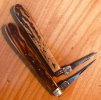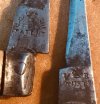- Joined
- Dec 2, 2005
- Messages
- 71,121
I sometimes have to smile at the wishful thinking that can go into dating old English folding knives, ('Spring Knives' as they are rightly called). In truth, they can be extremely difficult to date precisely, due to a number of factors I've mentioned many times before, in particular the idiosyncrasies of the 'Little Mester' system of production, which was dominant in Sheffield throughout the period of cutlery production there. There are, however, still a good number of hundred year-old Sheffield knives around, and some older than that, but it's not often that I come across one as old as this, certainly not in such a humble situation, and at a very modest price. Two hundred year-old knives are rare.

I picked this knife up in a West Yorkshire antiques shop, the other day. It had been part of what is called a 'house clearance' here, and had been unceremoniously dumped in a small bowl, together with a dozen later Sheffield knives, from the same estate. Unfortunately, it has been very roughly cleaned. All Quill Knives have some age to them, but in certain forms, they continued to be manufactured long after quill pens ceased to be commonly used, and often form part of a Lady's Reticule for example. This Quill Knife though is in the older, classic form, and while the blade is worn, it's form is still recognisable, with less wear than some may imagine. More importantly though, it is an inset scale knife, something which was popular from the late 18th century to the early 19th century. In fact, some early Barlow knives are inset scale knives.


While realising a few things about the knife though, I would certainly have struggled to date it if it were not for the convenient Royal device - a 'W' and 'R' placed on either side of a 'crown'. This stands for William Rex, King William IV of England, who reigned from 1830-1837. I have spent hours trying to work out what the rest of the stamp says. At first, I thought it might be the mark of John Hall, a Bradford cutler and maker of surgical instruments (I have a folding Surgeon's Knife of his), but I really don't know, the more I look at it, the less I can decipher what the ancient stamp says.


Unfortunately, the light has been unkind to me today too. If any of you folks with better eyesight reckon they can decipher what else this old knife tells us, and want to make a sensible guess, (please don't just further muddy the waters), please have a go. Otherwise, I thought some of you might like to see this. The knife is just as I found it, and I haven't cleaned it, or attempted to erase the mess left by whoever clumsily sought to do so. Nearly 200 years after it was made, it still has great walk and talk, and a centred blade.
Thanks for looking
Jack

I picked this knife up in a West Yorkshire antiques shop, the other day. It had been part of what is called a 'house clearance' here, and had been unceremoniously dumped in a small bowl, together with a dozen later Sheffield knives, from the same estate. Unfortunately, it has been very roughly cleaned. All Quill Knives have some age to them, but in certain forms, they continued to be manufactured long after quill pens ceased to be commonly used, and often form part of a Lady's Reticule for example. This Quill Knife though is in the older, classic form, and while the blade is worn, it's form is still recognisable, with less wear than some may imagine. More importantly though, it is an inset scale knife, something which was popular from the late 18th century to the early 19th century. In fact, some early Barlow knives are inset scale knives.


While realising a few things about the knife though, I would certainly have struggled to date it if it were not for the convenient Royal device - a 'W' and 'R' placed on either side of a 'crown'. This stands for William Rex, King William IV of England, who reigned from 1830-1837. I have spent hours trying to work out what the rest of the stamp says. At first, I thought it might be the mark of John Hall, a Bradford cutler and maker of surgical instruments (I have a folding Surgeon's Knife of his), but I really don't know, the more I look at it, the less I can decipher what the ancient stamp says.


Unfortunately, the light has been unkind to me today too. If any of you folks with better eyesight reckon they can decipher what else this old knife tells us, and want to make a sensible guess, (please don't just further muddy the waters), please have a go. Otherwise, I thought some of you might like to see this. The knife is just as I found it, and I haven't cleaned it, or attempted to erase the mess left by whoever clumsily sought to do so. Nearly 200 years after it was made, it still has great walk and talk, and a centred blade.
Thanks for looking
Jack



